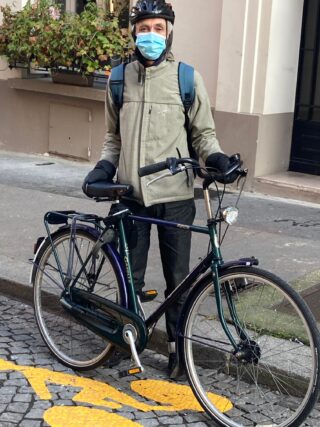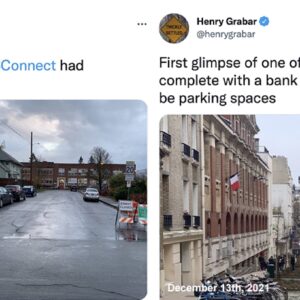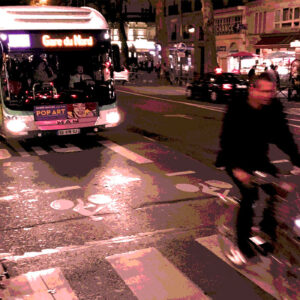— Reader Robert D’s view of riding to work on the streets of Paris was put into words by Lisa Caballero. Robert shot the raw video from his bike and it was edited by Jonathan Maus.
I relocated to Paris from Portland last November for a six-month work stint. I’ve commuted to work by bike for most of my 20 years in Portland, so I was eager to give daily commuting in Paris a try.

I won’t keep you in suspense—I was good at dodge-ball as a kid, so let’s just say that my Paris commute is exhilarating. But that is not the reason why I am writing this piece, or why I made a video of my commute. Rather, I think Paris has some lessons for Portland, the most important being that big improvements for cyclists can happen quickly—but they require boldness, vision and assertive leadership.
My commute begins on a “coronapiste” or “corona track,” one of over 50 kilometers (30 miles) of temporary protected bicycle lanes the city built in response to the pandemic. This particular coronapiste is on the Rue de Vaugirard which, at 2.7 miles, is the longest road in Paris. As I ride along, notice that the city has dedicated about 25 to 40% of the street cross-section to the bike lane—this on a major city street! The coronapistes were rapidly built with plastic bollards and small jersey barriers, recently Mayor Anne Hidalgo announced that the city would make them permanent.
Advertisement
[pdf-embedder url=”https://bikeportland.org/wp-content/uploads/2022/01/paris-map.pdf”] My commute
By removing car lanes, however, the traffic now moves more slowly. The presence of protected bike lanes not only gives people a safer place to ride, it has a traffic-calming effect.
From there I ride for a while in the bus lane on the Rue de Rennes (cyclists are allowed to use bus lanes). The next segment shows me on a “Shared Street.” I arrive at the Seine in the fourth segment, and ride on a section of the “express cycling network,” or REVe which was built as part of Plan Velo, the 2015-2020 bicycle plan. The REVe provides a north-south and east-west spine to the bicycle network, and also runs along the Seine.
Finally, in the last segment, I approach and traverse the rotary around the Place de la Bastille.
As you can see in the video, riding in Paris is pretty intense, you have to anticipate how a dense and varied group of street participants is going to act. It can be chaotic. Given that, it might be surprising to a Portlander how many women and older people ride bicycles here, and also parents with children on board, and children themselves. There are a couple of factors which help make the streets feel safer to everyone.
The first is speed. I’ve visited Paris regularly since the 1970s and I remember driving here and being uncomfortable as my fellow drivers tore down cobblestone streets at about 40 mph. It was hair-raising and I wouldn’t have dared to get on a bicycle. Like most cities at the time, Paris was given over to cars. By removing car lanes, however, the traffic now moves more slowly. The presence of protected bike lanes not only gives people a safer place to ride, it has a traffic-calming effect.
Advertisement
The second is attitude. I’ve yet to be yelled at by a driver in Paris. There is just less tension and hostility on the street. The number of people on bikes has reached a critical mass that makes riding feel safer (you are not alone, you are often in a crowd) and drivers know to look for other road users. There is not the “what are you doing on my road” attitude. It also helps that the cars are smaller. Despite being hectic, riding feels safer here.
I’ve yet to be yelled at by a driver in Paris. There is just less tension and hostility on the street.
Portland is not Paris, the six- to seven-story contiguous buildings which line every street here speak of a density which Portland does not have, and which allows for a mature transit network. But Paris is also not Amsterdam, which has had good bicycle infrastructure for decades. Rather, Paris teaches that a city can quickly transform itself from being dominated by cars to being a place that is safe, and pleasurable, for people to walk and bike. Paris might help Portlanders imagine how that can be; the speed at which this city changed is in itself inspiring.
How did it happen? In the spirit of never letting a good crisis go to waste, Paris leveraged the pandemic to overcome mode-change inertia. Plan Velo was already in place, but the general strike of December 2019 (which included transit workers) followed by the pandemic, let the city seize an opportunity to aggressively expand its bicycle network. As a result, Paris has seen 47% increase in the use of bike lanes, and nearly half of today’s cyclists are new to biking in the city.
Mayor Hidalgo has closely associated herself with this transportation revolution. With Plan Velo II (2021-2026), she plans to add another 80 miles of protected bike lanes with the goal of making 100% of Paris’s streets safely cyclable. In Paris, active transportation has active and energetic leadership. And that is the lesson, bike infrastructure doesn’t just happen, it requires visionary leaders who seize every opportunity for transformation. Paris shows what is possible.






Thanks for reading.
BikePortland has served this community with independent community journalism since 2005. We rely on subscriptions from readers like you to survive. Your financial support is vital in keeping this valuable resource alive and well.
Please subscribe today to strengthen and expand our work.
I understand the traffic culture is different between here and there, but around 0:24 (and elsewhere) you can see a pedestrian in a large painted crosswalk being squeezed into a tiny gap between the bike lanes and the car lanes, with cyclists appearing to only reluctantly yield; this looks like a fairly pedestrian-hostile design that I would not want to see replicated here.
I’d wager that where that ped is is not that tiny a spot. I only say that because other cycling videos I’ve watched (think downhill mtb stuff) make things look tight/narrow/impossible to get through until seen in real life. I could be wrong but that’s my thinking here.
In another spot, the gap is as narrow as the width of a curb. I don’t think it’s an illusion.
I just rewatched the video, I can’t tell if there is a signal or not, but the woman doesn’t look too worried to me. A surprising number of streets are signalized—signal for car, signal for bike, signal for pedestrian. Cyclists and pedestrians only loosely obey their signals. (And yes, the police set traps regularly.)
Also, remember, this is a coronapiste—it’s not meant to be permanent infrastructure. When Hidalgo announced they would be made permanent, my understanding was that they would be rebuilding them with permanent materials, so this will look more like the other infrastructure in the video, I think Hidalgo mentioned granite curbs. FWIW, I walk along Vaugirard weekly and it feels safe to me.
My point wasn’t that this design was inappropriate for Paris, but rather it would not translate well to Portland and the way we do traffic. Different cultures demand different solutions.
Your original comment reminded me of Pres. Obama’s famous quote: “Don’t let the perfect be the enemy of the good.” Portland is the absolute apotheosis of this dictum. Just look at how nothing can be done about the homeless crisis b/c every solution is imperfect.
I agree with that sentiment, but just because something works in France doesn’t mean it will work here. One big difference between our countries is our much better accommodation of disabled folks, and another is our driving culture. I am fairly confident that if such a facility were teleported to, say, Hawthorne or NW 23rd, it would not be well received.
This is not an argument for inaction: I think in those contexts we could build something better.
So beautifully written and stated. We absolutely need visionary, bold and courageous leadership if we are to inspire folks to ditch their private cars. The goal of 100% of streets being safely cyclable is of the utmost importance and one Portland ought to take up as well.
I, for one, continue to feel a fervor in Portland. Advocates are coming together with common cause and unified goals. We only have each other and we can only help our leaders transform our cities with a loving message and compassionate approach.
#25x30PDX (25% bike modeshare by 2030): Let’s do it, Portland!
Perhaps I’m being too pessimistic but…
It just seems like Portland’s opportunity for this kind of radical transformation passed us by. The time for it was the late aughts and early teens when bicycling was a major local topic that had people abuzz with excitement. City leaders had the opportunity to turn what was (in retrospect) a fad into something real and lasting, but they half-assed it.
The pandemic shutdown could have been another golden opportunity, but a few things kept it from happening:
1. Local attention and passions were (rightfully) focused on racial justice during the early months of the pandemic when things were most “shut down”.
2. The adversarial nature of the progressive and centrist wings of city government has turned PBOT into a dumping ground for Ted Wheeler’s rivals. Neither Eudaly nor Hardesty campaigned on transportation or have any expertise in the subject, and that why they were made PBOT commissioner; they were set up to fail, and fail they did.
This is not to say it’s a lost cause. I think through the incredibly hard work of the local transportation activist community we can create the opportunity again, it just seems like we’re a long way away right now.
I wonder what the commute would be like on the Metro. Ive always been able to get anywhere I want on their fabulous metro!
The fact that there are other cyclists around in almost the whole video is inspiring. drivers will expect cyclists if they are actively seeing them.
The network doesn’t actually look that wide or great, but it is enough to get people out on their bikes! that is what counts
Thank you for your comments everyone! I’ll respond to several.
Watts, my main point isn’t so much about Paris’s specific infrastructure (much of it is quite similar to what PBOT is doing) but rather the kind of assertive political leadership needed to get active transportation infrastructure built. That said, yes you are noticing something real, personal space is smaller here, like in NYC, and it took me some time to adapt coming from Portland. Lots of eye contact and situational awareness.
H, the Metro is great and my bike commute takes about the same time (40 min) as the train would. But commuting by subway gets old fast. What surprised me is that going around by bike makes (central) Paris feel smaller and more approachable.
Lowell, good comment, I agree we’ve missed opportunities. Since Sam Adams, the city has lacked visionary active transportation leadership. But what’s happened in Paris shows that a decade of political will can transform bicycling in a city.
Allan, I agree. So often we are treated to images of perfect infrastructure from places like Vancouver BC or Amsterdam. Paris infrastructure isn’t perfect, it’s a work in progress, but there really is a transportation transformation going on here (involving more than the bike lanes, they are rebuilding subway lines, many buses are 100% electric, others are hybrid and the engine stops in slow or stopped traffic, and they are planning to close the center to through car traffic). What surprised me is that everyone is riding, women, men, seniors, kids. Strength in numbers! How do we make that happen in Portland?
Thank you, Robert, for the great video. Like Lowell, I am not optimistic that something like this could be done in Portland. Lisa will remember when Sunday Parkways came to Southwest Portland for the first time (maybe 2011?). Sunday Parkways is a tradition where a few main roads are dedicated exclusively to cycling and walking for a few hours on a Sunday.
My most vivid memory of that experience was of the drivers complaining and yelling at the police and volunteer marshals b/c they were denied the use of their usual driving routes. Sunday Parkways never returned to SW Portland.
It would require some serious intestinal fortitude on the part of political leaders in Portland to wrest even a part of the precious ROW from drivers, who need to be turned into the people who cycle instead of drive.
Hi Robert: You mentioned personal space, which is a great articulation of what I was seeing in the video. Do you think there are other important differences in the outlooks of Parisians compared to Portlanders that make them more willing to accept such a transformation? Or do you think it just takes a strong leader willing to muscle dramatic change through without regard for what people think? (Paris has a lot more historic precedence for this approach than Portland does.)
I’m not sure how elections/politics work in Paris, but in Portland there is a very real risk of losing your job if enough of your constituents get angry enough (ref. Commissioners Hardesty and Ryan), and that limits how far ahead of residents you can get. I did some work in Montreuil (outskirts of Paris), and I recall that party played a much bigger role in local elections than it does here, which might provide a layer of insulation from voters.
It was a great video!
Comparative politics, a subject I have thought about! I’m opening a bottle of wine for dinner right now, how quickly can you make it here?
I don’t completely agree with what you are saying. At least at the local level, people vote for party programs/platforms rather than personalities. Paris has had socialist mayors since 2001.
I don’t think I noticed one cyclist without good bicycle handling skills. In addition there were quite a few reckless cyclists and scooter riders. A head on collision between two cyclists could cause considerably traumatic injuries or death. Not my idea of beginner and family friendly bike commuting. I prefer the bike lane on the side of the road. Faster riders such as I can then use the car lane to pass slower cyclists.
Many cyclists are not wearing helmets. Also, their helmets are not like the ones we have. They wear the smooth rounded ones. Similar to the ones motorcyclists wear.